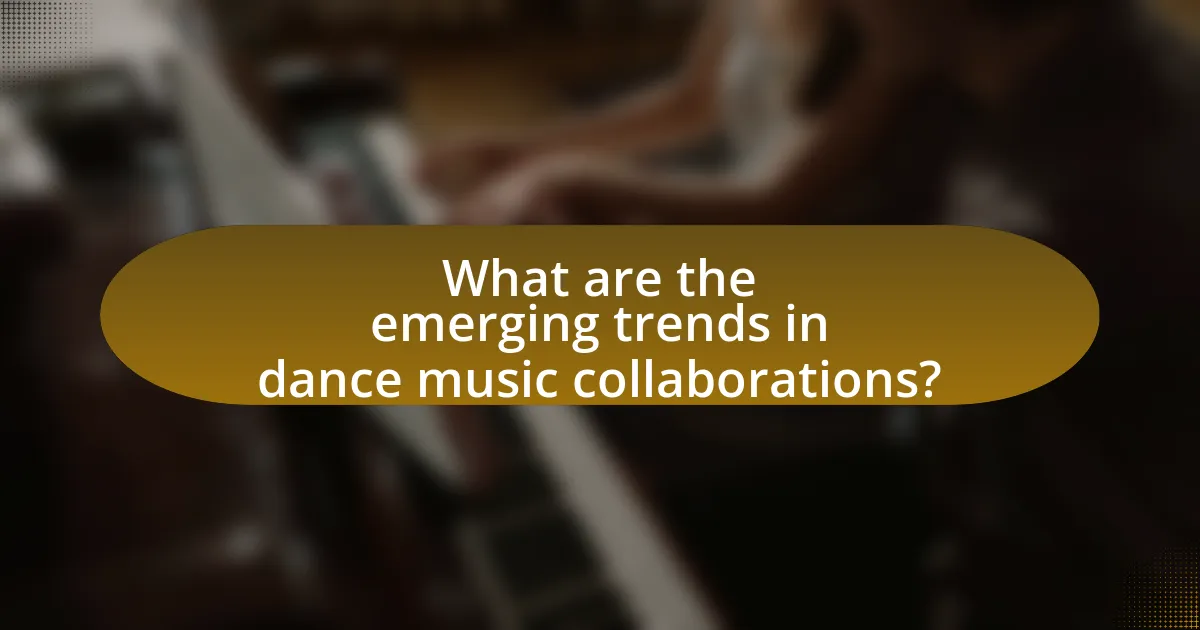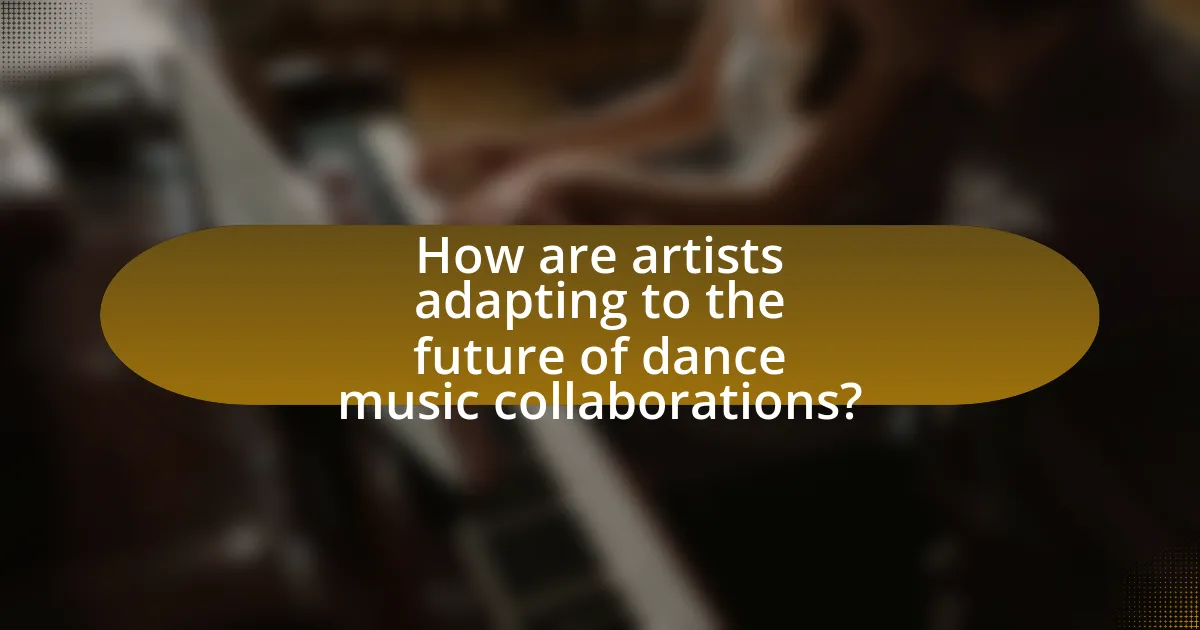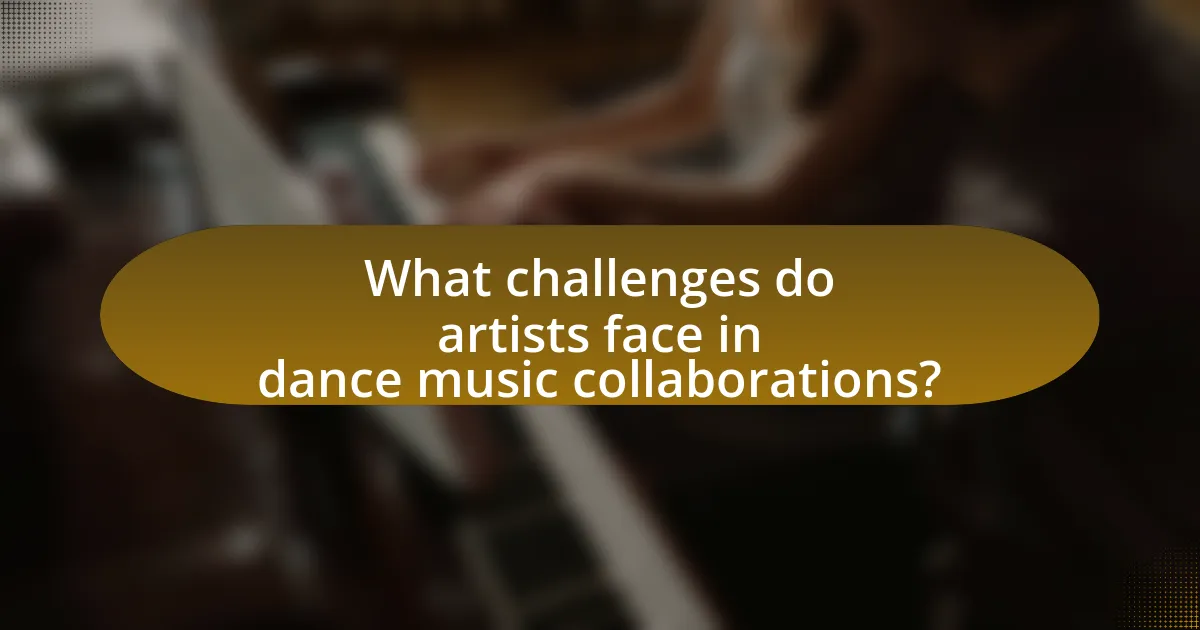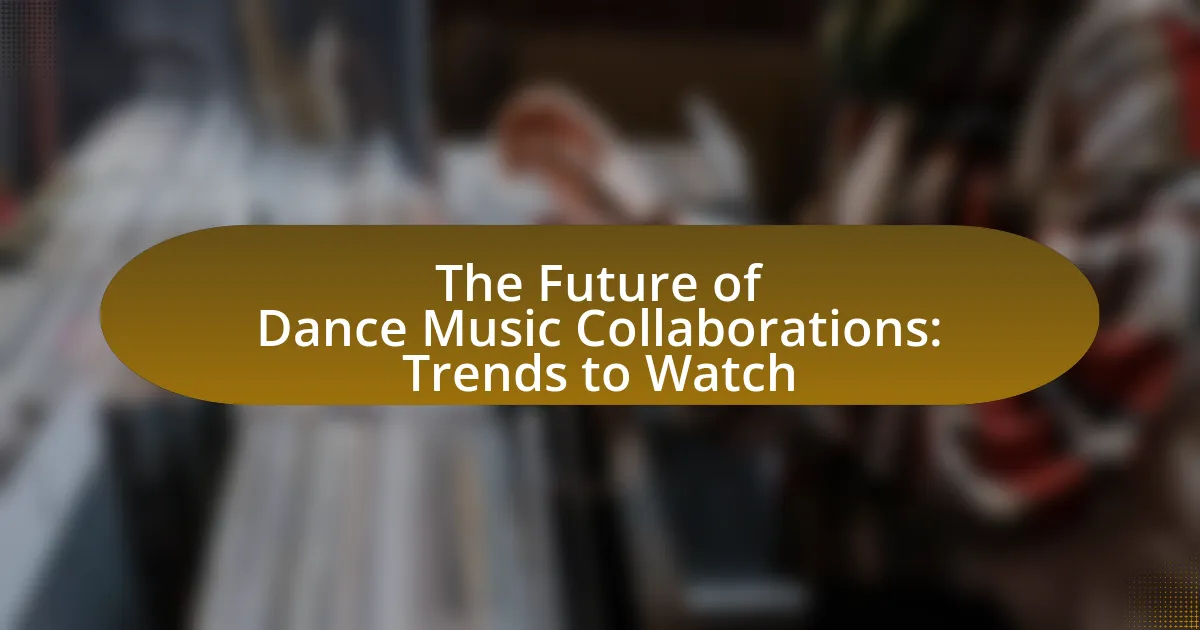The article focuses on the future of dance music collaborations, highlighting emerging trends such as cross-genre partnerships, technological advancements, and global influences. It examines how digital platforms and artificial intelligence are reshaping the creative process, facilitating remote collaborations, and enhancing audience engagement. Additionally, the article discusses the benefits and challenges of cross-genre collaborations, effective strategies for artists in the digital age, and the importance of mentorship and networking in artist development. Key elements of successful collaboration agreements and best practices for overcoming logistical challenges are also addressed, providing a comprehensive overview of the evolving landscape of dance music collaborations.

What are the emerging trends in dance music collaborations?
Emerging trends in dance music collaborations include cross-genre partnerships, increased use of technology, and a focus on global influences. Cross-genre collaborations are becoming more prevalent as artists from different musical backgrounds, such as hip-hop and pop, team up with electronic music producers to create innovative sounds. The integration of technology, such as virtual reality and artificial intelligence, is also shaping collaborations, allowing artists to connect and create music remotely, which has been accelerated by the COVID-19 pandemic. Additionally, artists are increasingly drawing inspiration from diverse cultural backgrounds, leading to a fusion of styles that reflects a more globalized music scene. These trends are supported by data showing a rise in collaborative tracks on streaming platforms, indicating a growing consumer appetite for diverse musical experiences.
How are technological advancements shaping collaborations in dance music?
Technological advancements are significantly shaping collaborations in dance music by enabling remote production, real-time communication, and access to a wider range of tools and platforms. Digital audio workstations (DAWs) like Ableton Live and FL Studio allow artists from different locations to collaborate seamlessly, sharing projects and ideas instantly. Additionally, cloud-based platforms such as Splice facilitate the exchange of samples and loops, fostering creativity among diverse artists. The rise of social media and streaming services has also expanded collaboration opportunities, allowing artists to connect and promote their work to global audiences. According to a 2021 report by the International Federation of the Phonographic Industry, 70% of music creators now collaborate online, highlighting the transformative impact of technology on the dance music scene.
What role do digital platforms play in facilitating these collaborations?
Digital platforms play a crucial role in facilitating collaborations in the dance music industry by providing accessible tools for communication, sharing, and distribution. These platforms enable artists to connect globally, share ideas, and collaborate on projects regardless of geographical barriers. For instance, services like SoundCloud and Splice allow musicians to upload, share, and remix tracks, fostering a collaborative environment. Additionally, platforms such as Zoom and Discord facilitate real-time communication and brainstorming sessions, enhancing the collaborative process. The rise of these digital tools has led to an increase in cross-genre collaborations, as evidenced by the growing number of partnerships between artists from different musical backgrounds, which has been documented in industry reports highlighting trends in music collaboration.
How is artificial intelligence influencing the creative process in dance music?
Artificial intelligence is significantly influencing the creative process in dance music by enabling artists to generate new sounds, automate production tasks, and enhance collaboration. AI tools, such as algorithms for music composition and sound design, allow producers to experiment with novel musical ideas and styles that may not have been possible through traditional methods. For instance, platforms like AIVA and Amper Music utilize machine learning to create original tracks, demonstrating AI’s capability to contribute creatively. Additionally, AI can analyze vast amounts of data from existing music to identify trends and preferences, helping artists tailor their work to audience tastes. This integration of AI not only streamlines the production process but also fosters innovative collaborations between human artists and machine-generated creativity.
What are the benefits of cross-genre collaborations in dance music?
Cross-genre collaborations in dance music enhance creativity and broaden audience reach. By merging different musical styles, artists can innovate and produce unique sounds that attract diverse listener demographics. For instance, collaborations between electronic and hip-hop artists have led to chart-topping hits, demonstrating the commercial viability of such partnerships. Additionally, these collaborations often result in increased exposure for lesser-known artists, as they tap into each other’s fan bases, thereby expanding their market presence. This trend is supported by data showing that tracks featuring multiple genres frequently perform better on streaming platforms, indicating a growing consumer preference for eclectic music styles.
How do collaborations enhance creativity and innovation in dance music?
Collaborations enhance creativity and innovation in dance music by merging diverse musical styles and perspectives, leading to unique soundscapes. When artists from different genres or backgrounds work together, they bring their individual influences, which can result in innovative production techniques and fresh ideas. For instance, the collaboration between David Guetta and Sia on “Titanium” combined electronic dance music with pop elements, creating a chart-topping hit that showcased the potential of cross-genre partnerships. This blending of styles not only broadens the artistic palette but also attracts a wider audience, demonstrating that collaborations can drive both creativity and commercial success in the dance music industry.
What impact do collaborations have on audience reach and engagement?
Collaborations significantly enhance audience reach and engagement by combining fan bases and leveraging diverse marketing strategies. When artists collaborate, they tap into each other’s audiences, which can lead to increased visibility and a broader listener demographic. For instance, a study by Nielsen Music found that collaborations can boost streaming numbers by up to 50% compared to solo releases. This increase in exposure often results in higher engagement rates, as fans are more likely to interact with content that features their favorite artists alongside others they may not have previously followed.

How are artists adapting to the future of dance music collaborations?
Artists are adapting to the future of dance music collaborations by leveraging technology and embracing diverse platforms for creative partnerships. Many musicians are utilizing online collaboration tools, such as cloud-based software and virtual studios, which allow them to work together regardless of geographical barriers. This shift has been accelerated by the COVID-19 pandemic, which forced artists to find innovative ways to connect and create remotely. Additionally, artists are increasingly engaging with social media and streaming platforms to promote collaborative projects, reaching wider audiences and enhancing fan interaction. For instance, the rise of TikTok has enabled artists to collaborate on viral dance challenges, further integrating their music into popular culture.
What strategies are artists using to collaborate effectively in the digital age?
Artists are using digital platforms, social media, and collaborative software to collaborate effectively in the digital age. These tools enable real-time communication, file sharing, and project management, which streamline the creative process. For instance, platforms like Splice and Soundtrap allow musicians to work together remotely, sharing samples and tracks seamlessly. Additionally, social media channels facilitate networking and promote collaborative projects, as artists can easily connect with peers and audiences. This shift towards digital collaboration has been supported by the rise of online communities and forums, where artists can exchange ideas and feedback, enhancing their collaborative efforts.
How do social media platforms influence collaboration opportunities?
Social media platforms significantly enhance collaboration opportunities by facilitating connections among artists, producers, and fans within the dance music community. These platforms enable users to share their work, seek feedback, and discover potential collaborators through features like hashtags, groups, and direct messaging. For instance, a study by the Pew Research Center found that 69% of adults in the U.S. use social media, which increases the likelihood of networking and collaboration across diverse geographical locations. Additionally, platforms like Instagram and TikTok allow artists to showcase their talents and reach wider audiences, leading to more collaborative projects and partnerships.
What are the best practices for remote collaboration among artists?
The best practices for remote collaboration among artists include establishing clear communication channels, utilizing collaborative tools, setting defined roles and responsibilities, and scheduling regular check-ins. Clear communication channels, such as video calls and messaging apps, facilitate effective dialogue and feedback, which is essential for creative processes. Collaborative tools like cloud storage and project management software enable artists to share files and track progress in real-time. Defining roles and responsibilities ensures that each artist understands their contributions, minimizing overlap and confusion. Regular check-ins help maintain momentum and address any challenges promptly, fostering a productive collaborative environment. These practices are supported by research indicating that structured communication and defined roles significantly enhance team performance in creative projects.
How are emerging artists leveraging collaborations to gain visibility?
Emerging artists are leveraging collaborations to gain visibility by partnering with established musicians and brands, which enhances their reach and credibility. These collaborations often result in cross-promotion, where both parties share their audiences, leading to increased exposure. For instance, a study by the International Music Summit in 2022 highlighted that 70% of emerging artists reported that collaborations with more prominent artists significantly boosted their streaming numbers and social media following. Additionally, collaborations can take various forms, such as joint tracks, remixes, or live performances, all of which create buzz and attract attention from industry stakeholders and fans alike.
What role do mentorship and partnerships play in artist development?
Mentorship and partnerships are crucial in artist development as they provide guidance, resources, and networking opportunities that enhance an artist’s growth. Mentorship allows emerging artists to learn from experienced professionals, gaining insights into the industry, artistic techniques, and career strategies. For instance, a study by the National Endowment for the Arts found that artists with mentors are more likely to achieve higher levels of success and satisfaction in their careers. Partnerships, on the other hand, facilitate collaboration, enabling artists to combine their strengths and reach broader audiences. Collaborations in dance music, such as those seen in festivals and joint projects, often lead to innovative sounds and increased visibility, further supporting an artist’s development.
How can collaborations help new artists break into the dance music scene?
Collaborations can significantly help new artists break into the dance music scene by providing access to established networks and audiences. When new artists partner with more experienced musicians or producers, they can leverage the latter’s fan base, which often leads to increased visibility and opportunities for performances. For instance, a study by the International Music Summit in 2021 highlighted that collaborations can increase streaming numbers by up to 50% for emerging artists, as they tap into the existing popularity of their collaborators. Additionally, working together allows new artists to learn from seasoned professionals, enhancing their skills and understanding of the industry, which is crucial for long-term success.

What challenges do artists face in dance music collaborations?
Artists face several challenges in dance music collaborations, including creative differences, communication barriers, and logistical issues. Creative differences often arise when artists have distinct musical visions or styles, leading to conflicts during the production process. Communication barriers can stem from varying levels of experience or language differences, which may hinder effective collaboration. Logistical issues, such as scheduling conflicts and the need for coordination across different locations, can also complicate the collaboration process. These challenges can impact the overall quality and success of the final product, as evidenced by numerous case studies in the music industry where unresolved conflicts led to stalled projects or unsatisfactory outcomes.
What are the common obstacles in collaborating across different genres?
Common obstacles in collaborating across different genres include differing artistic visions, communication barriers, and contrasting production techniques. These challenges arise when artists from distinct backgrounds have unique interpretations of music, which can lead to conflicts in creative direction. Additionally, varying levels of familiarity with genre-specific tools and software can hinder effective collaboration. Research indicates that successful cross-genre collaborations often require compromise and a willingness to learn from one another, as highlighted in studies on collaborative creativity in music.
How can creative differences be managed during collaborations?
Creative differences during collaborations can be managed through open communication and establishing a clear framework for decision-making. By fostering an environment where all participants feel comfortable expressing their ideas, collaborators can address conflicts early and find common ground. Research indicates that teams with strong communication skills are 25% more effective in resolving conflicts, leading to more successful outcomes in creative projects. Additionally, setting specific roles and responsibilities can help clarify expectations and reduce misunderstandings, further enhancing collaboration efficiency.
What legal considerations should artists be aware of when collaborating?
Artists should be aware of copyright, contract agreements, and intellectual property rights when collaborating. Copyright laws protect original works, meaning artists must ensure they have the right to use any pre-existing material in their collaborations. Contract agreements should clearly outline the roles, responsibilities, and profit-sharing arrangements among collaborators to prevent disputes. Additionally, understanding intellectual property rights is crucial, as it determines ownership of the created work and any potential revenue generated from it. These legal considerations are essential to safeguard the interests of all parties involved in the collaboration.
How can artists overcome logistical challenges in collaborations?
Artists can overcome logistical challenges in collaborations by utilizing digital tools for communication and project management. These tools, such as Slack for messaging and Trello for task organization, streamline coordination and ensure all collaborators are aligned on goals and deadlines. A study by the International Journal of Arts Management highlights that effective communication platforms can significantly enhance collaboration efficiency, reducing misunderstandings and delays. Additionally, establishing clear roles and responsibilities at the outset of a project minimizes confusion and enhances accountability among team members.
What tools and resources are available to facilitate collaboration?
Various tools and resources are available to facilitate collaboration in dance music, including digital audio workstations (DAWs), cloud storage services, and communication platforms. DAWs like Ableton Live and FL Studio enable multiple users to create and edit music tracks collaboratively. Cloud storage services such as Google Drive and Dropbox allow artists to share files and project assets seamlessly. Communication platforms like Slack and Discord provide real-time messaging and video conferencing, enhancing coordination among collaborators. These tools collectively streamline the creative process, making it easier for artists to work together regardless of geographical barriers.
How can effective communication improve collaboration outcomes?
Effective communication enhances collaboration outcomes by ensuring clarity, reducing misunderstandings, and fostering trust among team members. When individuals share ideas and feedback openly, they create an environment conducive to creativity and innovation, which is crucial in collaborative settings like dance music production. Research indicates that teams with strong communication practices are 25% more productive, as they can align their goals and expectations effectively. This alignment leads to more cohesive and successful projects, ultimately improving the quality of the collaborative work in the dance music industry.
What practical tips can artists follow to enhance their collaboration experiences?
Artists can enhance their collaboration experiences by establishing clear communication from the outset. Effective communication ensures that all parties understand their roles, expectations, and creative visions, which is crucial for a successful partnership. Research indicates that projects with defined communication protocols are 30% more likely to meet deadlines and achieve desired outcomes. Additionally, artists should set specific goals and timelines to maintain focus and accountability throughout the collaboration process. This structured approach not only fosters productivity but also helps in resolving conflicts efficiently, as evidenced by studies showing that teams with clear objectives report higher satisfaction levels. Lastly, embracing flexibility and openness to feedback can significantly improve the collaborative atmosphere, allowing for creative growth and innovation.
How can artists build a strong network for future collaborations?
Artists can build a strong network for future collaborations by actively engaging in industry events, utilizing social media platforms, and participating in collaborative projects. Engaging in industry events such as music festivals, workshops, and conferences allows artists to meet peers and industry professionals, fostering relationships that can lead to future collaborations. Utilizing social media platforms like Instagram, Twitter, and TikTok enables artists to showcase their work, connect with other artists, and engage with their audience, which can attract potential collaborators. Participating in collaborative projects, whether through joint performances or co-writing sessions, provides practical experience in teamwork and can lead to lasting professional relationships. According to a study by the Berklee College of Music, networking is crucial for artists, as 70% of music industry opportunities arise from personal connections.
What are the key elements of a successful collaboration agreement?
The key elements of a successful collaboration agreement include clear objectives, defined roles and responsibilities, effective communication protocols, and a framework for conflict resolution. Clear objectives ensure all parties understand the goals of the collaboration, while defined roles and responsibilities clarify each participant’s contributions. Effective communication protocols facilitate ongoing dialogue, and a framework for conflict resolution provides a structured approach to address disagreements. These elements are essential for fostering a productive partnership and ensuring that all parties are aligned throughout the collaboration process.
